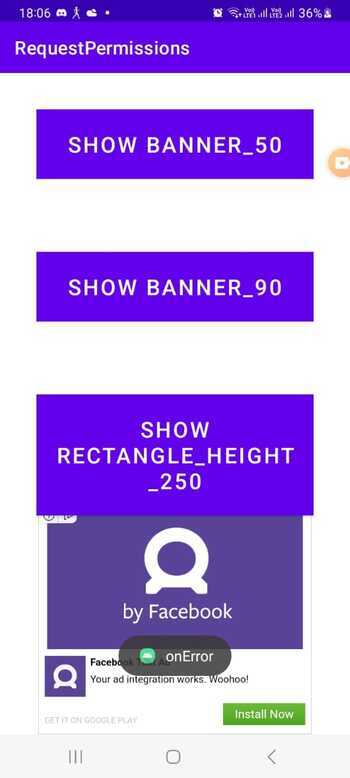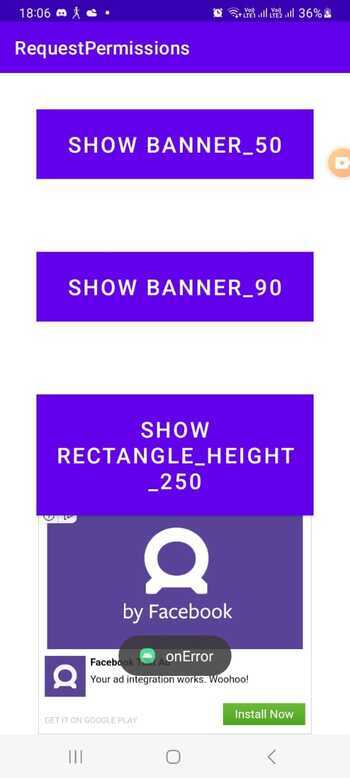
 Data Structure
Data Structure Networking
Networking RDBMS
RDBMS Operating System
Operating System Java
Java MS Excel
MS Excel iOS
iOS HTML
HTML CSS
CSS Android
Android Python
Python C Programming
C Programming C++
C++ C#
C# MongoDB
MongoDB MySQL
MySQL Javascript
Javascript PHP
PHP
- Selected Reading
- UPSC IAS Exams Notes
- Developer's Best Practices
- Questions and Answers
- Effective Resume Writing
- HR Interview Questions
- Computer Glossary
- Who is Who
How to Integrate Facebook Audience Network (FAN) Banner Ads in Android?
Integrating Facebook Audience Network (FAN) banner ads in Android allows developers to monetize their mobile applications by displaying targeted advertisements to users. FAN provides a seamless way to incorporate banner ads into Android apps, leveraging Facebook's vast user data and ad inventory.
By integrating FAN, developers can generate revenue through ad impressions and clicks, enhancing their app's profitability. This integration process involves incorporating the FAN SDK into the Android project and implementing the necessary code to request and display banner ads within the app's user interface.
By following the integration guidelines provided by Facebook, developers can effectively incorporate FAN banner ads and maximize their app's advertising potential.
Facebook Audience Network (FAN)
Facebook Audience Network (FAN) is an advertising platform provided by Facebook that allows mobile app developers and publishers to monetize their applications by displaying targeted ads to their users. It leverages Facebook's vast user data and ad inventory to deliver personalized and relevant ads, increasing the chances of engagement and conversion.
FAN offers various ad formats, including banner ads, native ads, interstitial ads, and rewarded videos, giving developers flexibility in choosing the most suitable ad type for their app.
Through the integration of the FAN SDK, developers can seamlessly incorporate these ads into their Android or iOS applications and generate revenue based on ad impressions and clicks. FAN provides robust targeting capabilities, optimization tools, and detailed analytics to help developers maximize their ad revenue and enhance the overall user experience.
Approaches
There are different methods to integrate Facebook Audience Network (FAN) banner ads in Android. Here are a few commonly used approaches:
Manual Integration
Gradle Integration
Third-Party Libraries
Manual Integration
This method involves manually adding the FAN SDK to your Android project. You need to download the SDK from the Facebook Developer website, extract the files, and include them in your project's dependencies. Then, you can follow the documentation and code samples provided by Facebook to implement the necessary code for requesting and displaying banner ads within your app.
Algorithm
Download the FAN SDK from the Facebook Developer website.
Extract the SDK files and include them in your Android project.
Implement the necessary code for initializing the FAN SDK in your app.
Create a banner ad placement in your app's layout XML file.
Request banner ads using the FAN SDK, specifying the ad placement ID.
Handle the ad responses and display the banner ads within your app's user interface.
Implement event listeners for ad clicks or other interactions and handle them accordingly.
Example
package com.example.requestpermissions;
import android.os.Bundle;
import android.view.View;
import android.view.ViewGroup;
import android.widget.Button;
import androidx.appcompat.app.AppCompatActivity;
import com.facebook.ads.*;
public class MainActivity extends AppCompatActivity {
private Button loadAdButton;
private ViewGroup adContainer;
private AdView adView;
@Override
protected void onCreate(Bundle savedInstanceState) {
super.onCreate(savedInstanceState);
setContentView(R.layout.activity_main);
// Initialize the Facebook SDK
AudienceNetworkAds.initialize(this);
loadAdButton = findViewById(R.id.loadAdButton);
adContainer = findViewById(R.id.adViewContainer);
loadAdButton.setOnClickListener(new View.OnClickListener() {
@Override
public void onClick(View v) {
loadBannerAd();
}
});
}
private void loadBannerAd() {
adView = new AdView(this, getString(R.string.banner_placement_id), AdSize.BANNER_HEIGHT_50);
AdListener adListener = new AdListener() {
@Override
public void onError(Ad ad, AdError adError) {
// Handle error
}
@Override
public void onAdLoaded(Ad ad) {
// Ad loaded
}
@Override
public void onAdClicked(Ad ad) {
// Ad clicked
}
@Override
public void onLoggingImpression(Ad ad) {
// Handle logging impression
}
};
adView.loadAd(adView.buildLoadAdConfig().withAdListener(adListener).build());
adContainer.addView(adView);
AdSettings.setDebugBuild(BuildConfig.DEBUG);
AdSettings.addTestDevice("YOUR_TEST_DEVICE_HASH");
adView.loadAd();
}
@Override
protected void onDestroy() {
if (adView != null) {
adView.destroy();
}
super.onDestroy();
}
}
Output

Gradle Integration
With this method, you can integrate FAN banner ads using Gradle, which is a popular build automation tool in Android development. You need to add the FAN SDK as a dependency in your app's Gradle build file. Once added, you can proceed with the code implementation and configuration steps as outlined in the Facebook Audience Network documentation.
Algorithm
Update your app's Gradle build file to include the FAN SDK as a dependency.
Sync the Gradle project to download the SDK files.
Implement the necessary code for initializing the FAN SDK in your app.
Create a banner ad placement in your app's layout XML file.
Request banner ads using the FAN SDK, specifying the ad placement ID.
Handle the ad responses and display the banner ads within your app's user interface.
Implement event listeners for ad clicks or other interactions and handle them accordingly.
build.gradle file
implementation 'com.facebook.android:audience-network-sdk:6.11.0'
Example
package com.example.requestpermissions;
import android.os.Bundle;
import android.view.View;
import android.widget.Button;
import android.widget.LinearLayout;
import android.widget.Toast;
import androidx.appcompat.app.AppCompatActivity;
import com.facebook.ads.Ad;
import com.facebook.ads.AdError;
import com.facebook.ads.AdListener;
import com.facebook.ads.AdSize;
import com.facebook.ads.AdView;
import com.facebook.ads.AudienceNetworkAds;
import com.facebook.ads.AdSettings;
public class MainActivity extends AppCompatActivity {
private Button fbBanner_50, fbBanner_90, fbBanner_250;
@Override
protected void onCreate(Bundle savedInstanceState) {
super.onCreate(savedInstanceState);
setContentView(R.layout.activity_main);
fbBanner_50 = findViewById(R.id.banner_50);
fbBanner_90 = findViewById(R.id.banner_90);
fbBanner_250 = findViewById(R.id.banner_250);
AudienceNetworkAds.initialize(this);
AdSettings.addTestDevice("ac80ad30-bdd4-483d-bb19-86cfd737904b");
fbBanner_50.setOnClickListener(new View.OnClickListener() {
@Override
public void onClick(View view) {
showBanner(AdSize.BANNER_HEIGHT_50);
}
});
fbBanner_90.setOnClickListener(new View.OnClickListener() {
@Override
public void onClick(View view) {
showBanner(AdSize.BANNER_HEIGHT_90);
}
});
fbBanner_250.setOnClickListener(new View.OnClickListener() {
@Override
public void onClick(View view) {
showBanner(AdSize.RECTANGLE_HEIGHT_250);
}
});
}
private void showBanner(AdSize adSize) {
AdView bannerAd = new AdView(
this, "166334129775882_166350076440954",
adSize);
LinearLayout adLinearContainer =
findViewById(R.id.fb_banner_ad_container);
adLinearContainer.removeAllViewsInLayout();
adLinearContainer.addView(bannerAd);
bannerAd.buildLoadAdConfig()
.withAdListener(new AdListener() {
@Override
public void onError(Ad ad, AdError adError) {
Toast.makeText(MainActivity.this, "Error loading
ad", Toast.LENGTH_SHORT).show();
}
@Override
public void onAdLoaded(Ad ad) {
Toast.makeText(MainActivity.this, "Ad loaded
successfully", Toast.LENGTH_SHORT).show();
}
@Override
public void onAdClicked(Ad ad) {
Toast.makeText(MainActivity.this, "Ad clicked",
Toast.LENGTH_SHORT).show();
}
@Override
public void onLoggingImpression(Ad ad) {
Toast.makeText(MainActivity.this, "Logging
ad impression", Toast.LENGTH_SHORT).show();
}
})
.build();
bannerAd.loadAd();
}
}
Output

Conclusion
In this tutorial, integrating Facebook Audience Network (FAN) banner ads in Android provides developers with an effective way to monetize their apps by displaying targeted advertisements to users. Whether through manual integration, Gradle integration, or leveraging third-party libraries, developers can incorporate FAN banner ads seamlessly into their Android applications, generating revenue through ad impressions and clicks. With FAN's robust targeting capabilities and optimization tools, developers can maximize their ad revenue potential while enhancing the overall user experience.

